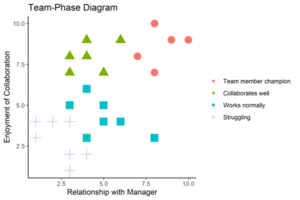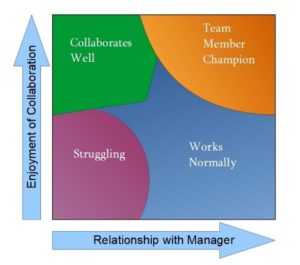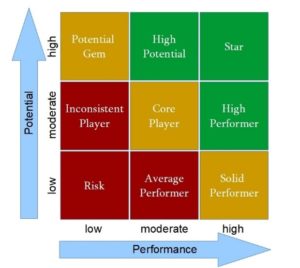In elementary school many of us were taught the states of matter were solid, liquid, and gas (those of us who enjoyed science may also have learned about plasma and other states, but we’ll ignore anything outside classical thermodynamics for this analogy). A state of matter can be defined as “properties that emerge under certain conditions.” Using that definition and some scientific tools might help us better understand why employees work well on some teams and not on others.
For the solid, liquid and gas phases of water, the two conditions that cause phase change are temperature and pressure. Those conditions don’t change the individual makeup of the H2O molecules, but they do change how the molecules function as a group. Water only becomes wet when it changes to a liquid. Solid ice doesn’t levitate off the sidewalk, but clouds float far above us. The H2O molecules stay the same even when the group’s activities shift based on the state they are in (this is like employees who work poorly on one team and then are top performers when moved to a different team).
Scientists have developed phase diagrams to show what phase states emerge in different conditions. A common phase diagram will have pressure on one axis and temperature on the other. By looking up the temperature and pressure, we can see what phase the substance will be in. Similarly, we can see the amount of temperature or pressure needed to shift the substance into a different phase.
Modeling humans like states of matter is not a new concept; it’s been useful in many areas of analytics. When there is a large town square with a diffused group of people walking around, individuals tend to function as a gas going in their own directions. This is quite different than a crowded high school hallway when everyone is rushing to class; a phase transition occurs, and now the system acts more like a liquid in which students group up and move together to slide around other groups. This can often feel like currents passing by each other or even waves ebbing and flowing. In certain situations (like in a stampede of Black Friday shoppers), this liquid-like force creates waves so strong they can crush people to death. Modeling human groups like liquids allows us to use phase tools to decrease the waves and hopefully create a phase change back to a more gas-like group.
Going much further, physicist Max Tegmark proposed that human consciousness could be thought of like a state of matter.[1] Just like we can think of temperature and pressure as the conditions for water’s phases, Tegmark proposes we can think of memory, computation and information integration as the conditions that create emergent properties like self-awareness.
As basketball legend Michael Jordan stays, “talent wins games, but teamwork and intelligence win championships.” From a Human Resources perspective, it may be possible to model team dynamics with phase diagrams. This could show us what is needed to shift a group of talented individuals into a championship team, the same way temperature and pressure shift water from a heavy liquid to a lighter-than-air gas. Are there dominant conditions that influence team dynamics in the same way temperature and pressure influence water? If there are, what are the emergent properties of the teams at different points in the phase diagram?
Modern HR demands that we test the model, not just theorize about the correct answers. Applying people analytics is challenging since humans are complex, but we are leveraging tools (everything from surveys to organizational network analysis) that may help with this task. The better we can refine those tools, the more useful models we can create http://loans-cash.net/faq.php .
If we wanted to create a team-phase diagram, we may start with finding which survey questions are the most relevant. These questions will be used for the “temperature” and “pressure” axes of the phase diagram. For this fictional scenario let’s imagine a survey that has very telling results for the two questions:
1) How is your relationship with your manager?
1 Poor – to – 10 Amazing
2) How much do you enjoy collaborating with your team?
1 Poor – to – 10 Amazing
Separately, we want to connect these to emergent properties of the team. If we feel our managers are well-trained in understanding team insights, we may ask them to help identify how the team is working. For this scenario, we ask the managers to observe their employees and categorize them into 4 buckets:
- Struggling – often has problematic conflicts with team members
- Works normally – standard interactions with team members
- Collaborates well – often has productive team interactions
- Team member champion – develops elevated levels of cooperation and a strong team spirit in others

After running the employee survey and the manager categorization, we can merge both data sets. Mapping these as a team-phase diagram, we may find results like this, where each point is an employee:
This team-phase diagram makes it quite easy to see how the 4 groups (based on manager identification) are related to the survey responses (based on employee sentiment). In this fictional data, employees whom the manager identified as “Struggling” have a low rating of both “enjoyment of collaboration” and “manager relationship.” Employees who the manager identified as “Collaborates well” have a high “enjoyment of collaboration score,” but a lower “manager relationship.”
 Looking at the phase diagram, it becomes clear which areas are hurdles for each team member. Human Resources could target these areas through training or reorganizations and see if the results change. If the goal is to shift employees from “Collaborates well” to “Team member champion,” then HR knows to focus on improving those employees’ relationships with their managers (moving them to the right on the team-phase diagram). This could come in the form of coaching the manager, or it could involve transferring the employee to a different manager.
Looking at the phase diagram, it becomes clear which areas are hurdles for each team member. Human Resources could target these areas through training or reorganizations and see if the results change. If the goal is to shift employees from “Collaborates well” to “Team member champion,” then HR knows to focus on improving those employees’ relationships with their managers (moving them to the right on the team-phase diagram). This could come in the form of coaching the manager, or it could involve transferring the employee to a different manager.
This fictional scenario is overly simplistic with data designed to illustrate strong signals. With live data, finding the relationship between the right conditions and emergent properties would be challenging, though well worth the effort for the employee insights it provides. The point of this exercise is to show a simplified version of the team-phase diagram that can be tested by many different teams to generate real insights for their specific populations.
 The team-phase diagram can be considered the next evolutionary step of HR’s “9-box” work. Potential and performance are the conditions in the 9-box model. As an employee is ranked higher in both conditions, they are considered as having properties that make them a better employee. However, the 9-box fails because it doesn’t predict anything – there are no emergent conditions related to the factors. The 9-box just reinforces subjective judgments: it’s not designed to use employee data, and it is not inherently testable. Moving from a 9-box to something closer to a team-phase diagram will help us verify and refine the model over time to really understand what levers make a difference in our teams.
The team-phase diagram can be considered the next evolutionary step of HR’s “9-box” work. Potential and performance are the conditions in the 9-box model. As an employee is ranked higher in both conditions, they are considered as having properties that make them a better employee. However, the 9-box fails because it doesn’t predict anything – there are no emergent conditions related to the factors. The 9-box just reinforces subjective judgments: it’s not designed to use employee data, and it is not inherently testable. Moving from a 9-box to something closer to a team-phase diagram will help us verify and refine the model over time to really understand what levers make a difference in our teams.
Psychology is an incredibly complex field, and a team-phase diagram approach to understanding group dynamics will always be an over-simplification. However, it may be a useful abstraction for analyzing dynamics across teams, giving HR the insights to know what properties to shift to achieve the right emergent conditions.
Just like the same H2O atoms exist in ice, liquid water, and water vapor, the same people work on different teams. The reasons someone succeeds on one team and not on another, or why some teams are high performing while others are not, might be unlocked by developing team-phase diagrams like this.
This article was inspired by, and takes examples from, the How Many States Of Matter Are There?(https://www.youtube.com/watch?v=184eP_KuXek) episode of Space Time with astrophysicist Matt O’Dowd.
Endnotes
[1] https://doi.org/10.48550/arXiv.1401.1219


